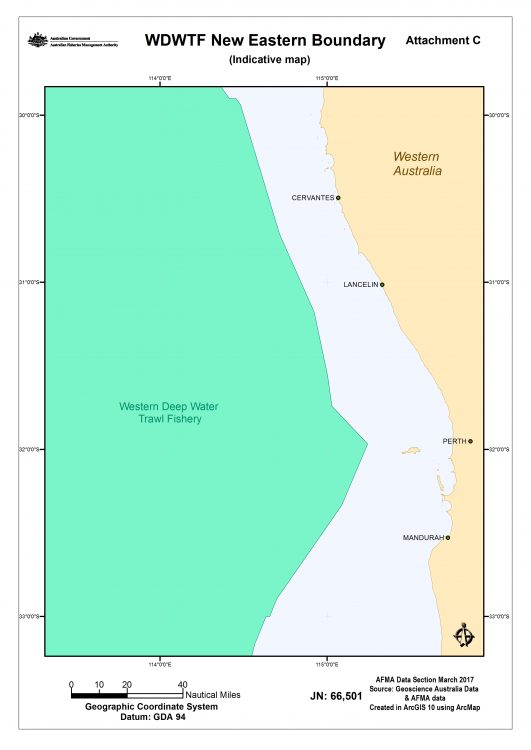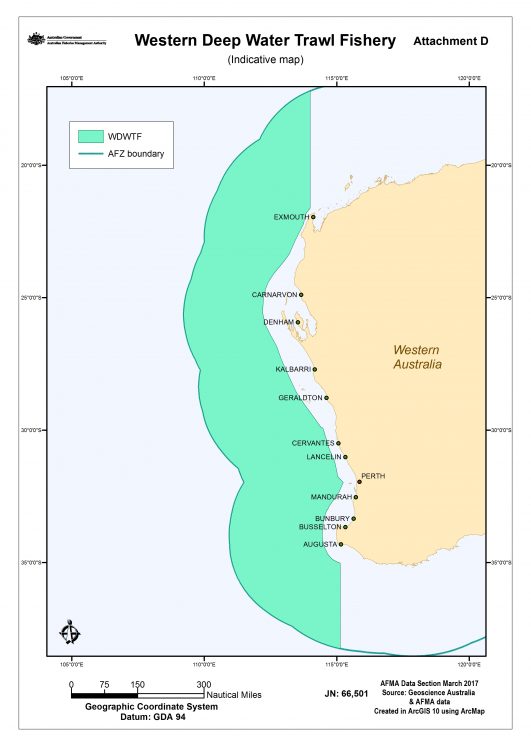The Western Deepwater Trawl fishery is managed by limited entry, and operators must hold a permit that allows them to fish.
It is best defined as a mixed species fish trawl fishery due to the wide range of species taken at low volumes.
There has been a recent change to Western Deepwater Trawl fishery boundary.
Historical catch
| Species | 2023–24 catch (tonnes) | 2022–23 catch (tonnes) | 2021–22 catch (tonnes) |
|---|---|---|---|
| Deepwater bugs | 0 | 0 | 0 |
| Ruby snapper | 0 | 0 | 5 |
| Other species | 3 | 0 | 7 |
Total fishery value
Confidential due to the small number of boats in the fishery.
Fishing gear
Read more about bottom trawl.
Location
The Western Deepwater Trawl Fishery is located in water deeper than 200 metres off the coast of Western Australia from Exmouth to Augusta.
Major landing ports
- Fremantle
- Carnarvon.
Markets supplied
- Fresh and frozen product – domestic (Perth, Sydney and Brisbane)
- Frozen product – international (United States, Spain, China and Japan).
Fishing season
12 month season, beginning 1 July.
Fishing in the fishery
To fish in the fishery fishers must hold a valid fishing permit. Permits specify the area of operation, the boat being used, fishing methods used and species allowed to be taken. Under these permits fishers are also required to have a functioning vessel monitoring system and carry an observer when requested to do so.
There are 11 fishing permits (maximum number of vessels active at one time) each with a five-year duration in the Western Deepwater Trawl Fishery.
There are specific requirements that fishers must meet when fishing in the Western Deepwater Trawl Fishery.
Download a copy of the latest Management Arrangements for the Western Deepwater Trawl Fishery for a full description of all fishing requirements in the fishery.
Management plan
There is no formal management plan for the fishery. The fishery is informally managed through fishing permit conditions.
We recognise that managing fisheries involves a broad range of stakeholders including industry, scientists, environmental groups, the community and management.
Engaging with our stakeholders allows us to make informed decisions regarding fisheries management.
Fishing industry
Each fishing season, AFMA officers visit the major fishing ports of the fishery. These visits allow AFMA and fishers to meet directly to discuss any concerns. Discussions about the current trends in fishing and catches during the season are also valuable information gained on these visits. All this information is useful for the continuing management of the fishery.
Recreational fishers
Many of the fish species caught by commercial fishers in the fishery are also caught by recreational fishers. The recreational fishing of these species is managed by the state governments.
Government departments
AFMA works closely with other government departments, such as the Department of Agriculture, Fisheries and Forestry and the Department of Climate Change, Energy, the Environment and Water. They help in providing advice and guidance on both domestic and international fisheries issues.
State governments
The Australian state governments manage fishing from the Australian coast out to 3 nm. Occasionally there is some overlap in fishing operations between the state and commonwealth jurisdictions and AFMA regularly communicates with the state fisheries agencies to manage any problems.
Representatives from the state fisheries agencies also attend the management advisory committee meetings.
AFMA uses many methods to monitor the compliance of fishing activities. These include:
Onboard observers
One of the main monitoring methods used by AFMA is onboard scientific observers. These observers are people employed by AFMA to go out on boats and independently record the catch, effort and biological information of each fishing trip.
They take samples from fish, such as the otoliths or ear bones, and use these to determine the age of the fish caught.
Observers also record the length, weight and sex of each fish caught during a trip and report on the other wildlife that may be seen, the weather conditions, the composition of commercial catch fate of species that are caught as bycatch.
Boats in the fishery must carry an AFMA observer when requested by AFMA.
Read more about our Observer program.
Satellite tracking
A satellite monitoring system called a Vessel Monitoring System or VMS for short, is fitted to each concession holders boat. This system helps AFMA to monitor vessel position, course and speed. The tracking unit regularly transmits the information through a communications satellite to a land earth station. This information is sent by secure internet connection to a database at AFMA.
Read more about our satellite tracking program.
Cameras on fishing boats – electronic monitoring
AFMA has electronic monitoring systems on some fishing boats. These systems have sensors linked to surveillance cameras that record fishing activity such as the impacts of some fishing methods on protected species. These recordings can then be collected and monitored by AFMA. Electronic monitoring gives fishers a cost effective way to support monitoring and data collection.
Read more about electronic monitoring of fishing boats.
Trigger reports
There has been a recent change to Western Deepwater Trawl fishery boundary.
Western Deepwater Trawl New Eastern Boundary

Western Deepwater Trawl Fishery
